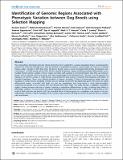Identification of Genomic Regions Associated with Phenotypic Variation between Dog Breeds using Selection Mapping
Author(s)
Vaysse, Amaury; Ratnakumar, Abhirami; Derrien, Thomas; Axelsson, Erik; Pielberg, Gerli Rosengren; Fall, Tove; Seppälä, Eija H.; Hansen, Mark S. T.; Lawley, Cindy T.; Bannasch, Danika L.; Vilà, Carles; Lohi, Hannes; Galibert, Francis; Fredholm, Merete; Häggström, Jens; Hedhammar, Åke; André, Catherine; Hitte, Christophe; Webster, Matthew T.; Sigurdsson, Snaevar; Karlsson, Elinor K.; Lindblad-Toh, Kerstin; ... Show more Show less
DownloadVaysse-2011-Identification of ge.pdf (1.497Mb)
PUBLISHER_CC
Publisher with Creative Commons License
Creative Commons Attribution
Terms of use
Metadata
Show full item recordAbstract
The extraordinary phenotypic diversity of dog breeds has been sculpted by a unique population history accompanied by selection for novel and desirable traits. Here we perform a comprehensive analysis using multiple test statistics to identify regions under selection in 509 dogs from 46 diverse breeds using a newly developed high-density genotyping array consisting of >170,000 evenly spaced SNPs. We first identify 44 genomic regions exhibiting extreme differentiation across multiple breeds. Genetic variation in these regions correlates with variation in several phenotypic traits that vary between breeds, and we identify novel associations with both morphological and behavioral traits. We next scan the genome for signatures of selective sweeps in single breeds, characterized by long regions of reduced heterozygosity and fixation of extended haplotypes. These scans identify hundreds of regions, including 22 blocks of homozygosity longer than one megabase in certain breeds. Candidate selection loci are strongly enriched for developmental genes. We chose one highly differentiated region, associated with body size and ear morphology, and characterized it using high-throughput sequencing to provide a list of variants that may directly affect these traits. This study provides a catalogue of genomic regions showing extreme reduction in genetic variation or population differentiation in dogs, including many linked to phenotypic variation. The many blocks of reduced haplotype diversity observed across the genome in dog breeds are the result of both selection and genetic drift, but extended blocks of homozygosity on a megabase scale appear to be best explained by selection. Further elucidation of the variants under selection will help to uncover the genetic basis of complex traits and disease.
Date issued
2011-10Department
Broad Institute of MIT and HarvardJournal
PLoS Genetics
Publisher
Public Library of Science
Citation
Vaysse, Amaury et al. “Identification of Genomic Regions Associated with Phenotypic Variation Between Dog Breeds Using Selection Mapping.” Ed. Joshua M. Akey. PLoS Genetics 7.10 (2011): e1002316. Web. 23 Feb. 2012.
Version: Author's final manuscript
ISSN
1553-7390
1553-7404